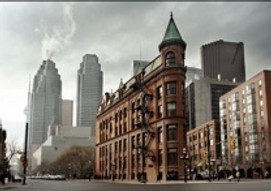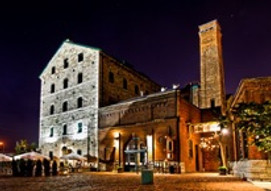In 1976 The Esplanade - a downtown Toronto planned community - was created with a pioneering vision of diversity. Today it is home to a very diverse population - with Esplanadians of all ages, abilities, household incomes and cultural backgrounds living together. We come from distant horizons, and yet together we live a harmonious and friendly day-to-day life.
However, with such a wide diversity, how do we ensure that intercultural understanding prevails; that economical disparity does not build walls between families; that both people with special needs and seniors are engaged and connected; and that all young people have an opportunity to express their unique voices?
We believe that part of the solution is to offer inter-generational programming that is free and accessible by all, along with an inclusive, accepting and welcoming environment where all people can connect, gather and create together. We believe that offering both access and engagement opportunities in the arts contributes to a more cohesive, united and supportive community.
Jamii serves The Esplanade neighbourhood. What makes this area of Toronto so unique?
The Esplanade is a downtown Toronto community purposefully developed in the 1970's as a new model for urban planning centred around people from socially and economically diverse backgrounds. In 2020, The Esplanade continues to be a "people" focused community that welcomes and embraces a rich mosaic of ethnic groups. This community is considered to be one of the most successful municipally organized inner-city redevelopments in Canada. The Esplanade (original site plan for the St Lawrence Neighbourhood) is home to about 15,000 people – people who represent Jamii’s primary audience and project participants.
The pioneering vision of diversity this community was built on encompasses cultural, multigenerational, socio-economical diversity while also embracing universal design for accessibility. Our cultural diversity was nurtured through the specific offering of social housing residences to cultural groups that include eastern European, Francophones, East Africans, and Russians.
Our community is welcoming of people of all ages with 3 daycares, 2 schools, and 3 senior homes. People of all socio-economical status mingle with one another as neighbours from co-ops, social housing, private homes and condos. It’s conceived and developed with specific architectural intent so that socio-economic status would not be evident based on where one lived. As well, a specific percentage of fully accessible units were allocated to a significant segment of the residential buildings in the community. Accessibility is a main feature of our neighbourhood thanks to its promenade: a green artery along Crombie Park, connecting our community from East to West. The promenade is also the social hub of our community: when locals walk down the promenade, they can be seen regularly waving to one another.
The Esplanade, nestled between the Distillery District and the St Lawrence Market, steps away from the lake, is a gem surrounded by high-caliber artistic institutions. It feels like a village in the City. It feels like home.
This inside knowledge, specifically on the design intent of the community, comes from Alan Littlewood, one of the architects of The Esplanade, who was on the board of directors of Jamii for its first few years, as well as former Mayor David Crombie, who was the first person to support the creation of Jamii.
Ontario Federation of Indigenous Friendship Centres (OFIFC)
"Founded in 1971, OFIFC works to support, advocate for, and build the capacity of member Friendship Centres across Ontario.
Friendship Centres are dynamic hubs of economic and social convergence that create space for Indigenous communities to thrive. Friendship Centres are idea incubators for young Indigenous people attaining their education and employment goals, they are sites of cultural resurgence for Indigenous families who want to raise their children to be proud of who they are, and they are safe havens for Indigenous community members requiring supports."
St. Lawrence Market
“In 1803, Governor Peter Hunter issued a proclamation, following recommendations made as early as 1796, that all the land north of Front, west of Jarvis, south of King and east of Church street was to be designated officially as the "Market Block."
Since 1901, the South St. Lawrence Market has been known primarily for its fruits, vegetables, meat and cheese. For many years, few people realized that Toronto's original City Hall had been incorporated into today's south market. The history of the South St. Lawrence Market also includes the north "farmer's market" and St. Lawrence Hall as well."
Market Lane Public School
"We are dedicated to the nurturing of independent, life-long learners through individual academic achievement and social responsibility. We value our unique diversity and model inclusionary practices within a safe and peaceful learning environment. We foster accountability, pride, respect and responsibility."
St. Lawrence BIA
The St. Lawrence Market Neighbourhood Business Improvement Area is a non-profit organization whose membership includes every business and commercial property owner within the St. Lawrence Market Neighbourhood. The BIA work cooperatively to improve the public realm, promote the neighbourhood and events, and support local business.
Flatiron Building
The red-brick Gooderham Building (Flatiron Building) is historic landmark of Toronto. The building, completed in 1892, was built by architect David Roberts, Jr. and originally cost $18,000 to construct for distiller George Gooderham, son of Gooderham & Worts distillery founder William Gooderham. It was the office of the Gooderham & Worts distillery until 1952 and sold by the Gooderham Estate in 1957.
Saved by David and Thomas Walsh, restoration took place in 1998 by owners Michael and Anne Tippin. The building was declared a historic site under the Ontario Heritage Act in 1975, and then in 1977 the Ontario Heritage Trust attained a Heritage Easement.
St. Lawrence Co-Operative Daycare
St Lawrence Co-Operative Day Care
3 locations:
- 230 The Esplanade
- 2 Princess St.
- 4 Market Street
The Day Care has been in operation since 1979 and believes children learn through play. Play is the cornerstone where children have the opportunity to actively explore and learn through materials and their environment.
Canadian Stage
The Canadian Stage Company was founded through the merger of CentreStage and Toronto Free Theatre. Canadian Stage officially came into existence in March of 1988 with its production of B-Movie, The Play written by Tom Wood and directed by Bob Baker.
Canadian Stage’s mission is to present work that is global, sometimes blurs the line between the performing arts disciplines, and is brought to life by artists with distinctive, contemporary voices.
Distillery District
Nearly 15 years ago a small group of visionary developers had a dream for Toronto. They looked at a derelict collection of Victorian Industrial buildings that had been pronounced a national historic site and imagined transforming it.
Their vision was to combine the romance and relaxing atmosphere of European walking and patio districts with the hip, cool dynamic of an area like New York City's SoHo or Chelsea, where creative minds get together and you feel as if anything could happen.
Young People's Theatre
From the very beginning, Young People’s Theatre established its dedication to professional productions of the highest quality from Canada and around the world, written just for children and the people who care about them.
Now, after 50 years, YPT is bursting at the seams with highly engaged audiences, bustling drama school classes, strong community partnerships, and innovative in-school programming. Today’s YPT enjoys a reputation for deeply meaningful experiences for all.


















